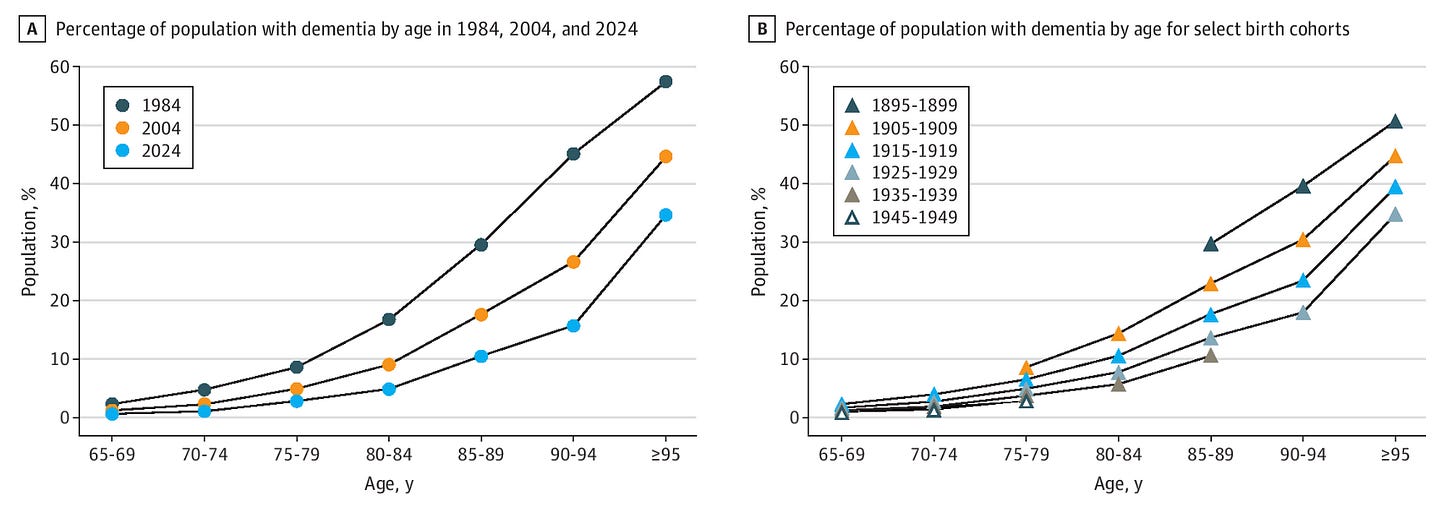Weekly Progress Roundup
Milei’s economic reforms are bearing fruit, an AI therapy trial delivers promising results, dementia prevalence is dropping in every age group, and more.
Milei’s economic reforms are bearing fruit in Argentina
Javier Milei’s Argentina is rapidly becoming the exemplar of prudent economic policy in the Americas.
According to Argentina’s national statistics agency, the poverty rate in the second half of 2024 was 38.1 percent—a 3.6 percentage point drop from when Milei took office in December 2023. Monthly inflation is now hovering between 2 and 3 percent, down from 25 percent in late 2023.
It’s worth noting that part of Milei’s strategy involves unilateral trade liberalization. Since taking office, he loosened import limits, slashed tariffs, and scrapped customs regulations, giving Argentinian consumers access to a bounty of cheap foreign goods and forcing domestic producers to become more competitive.
First-ever trial of AI therapy delivers promising results
Researchers at Dartmouth College recently published the results of the first-ever clinical trial of AI therapy.
The trial involved 210 participants who were randomly assigned to a 4-week program with Therabot, a generative AI chatbot trained on a curated dataset of therapeutic conversations.
According to a Dartmouth press release, patients with depression, anxiety, or an eating disorder reported an average symptom reduction of 51 percent, 31 percent, and 19 percent, respectively.
Dementia is becoming less common in every age group in the United States
The risk of developing dementia increases with age, so as the US population has grown older, dementia has become more common.
However, adjusting for age reveals an opposing trend. After analyzing long-term studies on tens of thousands of elderly Americans, a group of Duke University scientists found that, over the past 40 years, the age-specific prevalence of dementia has fallen by an astounding 67 percent.
The charts from their paper (below) show the share of the population with dementia on the vertical axis, with 5-year age groups extended chronologically on the horizontal axis.
On the left, each line represents a snapshot in time. You can see that dementia has become less common in every age group since 1984.
The chart on the right presents the same data using birth cohorts, or groups of people born during a certain time period. For example, the line with orange points represents people born between 1905 and 1909. In that cohort, 23 percent of people developed dementia by their late 80s. In the 1935 cohort, only 11 percent did. For the most recent 1945 cohort, that’s expected to fall to 8 percent.
A similar trend has been documented in Europe.
Economics & Development:
Energy & Environment:
Small Modular Nuclear Reactors Could Come to Michigan in 2030
Rare Virginia Grasshopper Spotted for First Time in 79 Years
Health & Demographics:
Drug Reduces Mysterious Particle Involved in Heart Attack Risk
Strongest Evidence Yet That Shingles Vaccine Helps Cut Dementia Risk
Pakistan Edges Closer to Eliminating Maternal and Neonatal Tetanus
Genomics “World Speed Record” Set in Confirming Ebola Outbreak
FDA Approves At-Home Test for Sexually Transmitted Infections
FDA Approves First New Antibiotic for Uncomplicated UTIs in Decades


